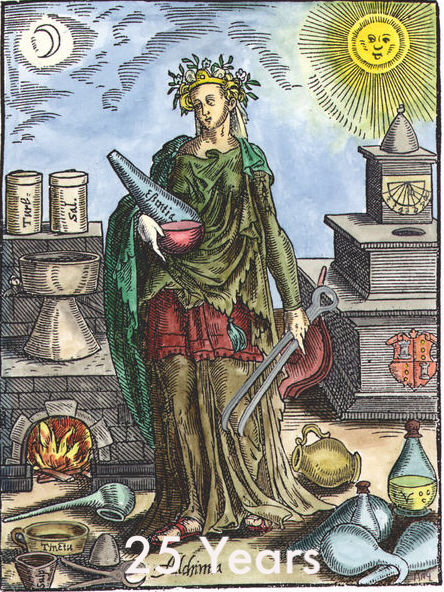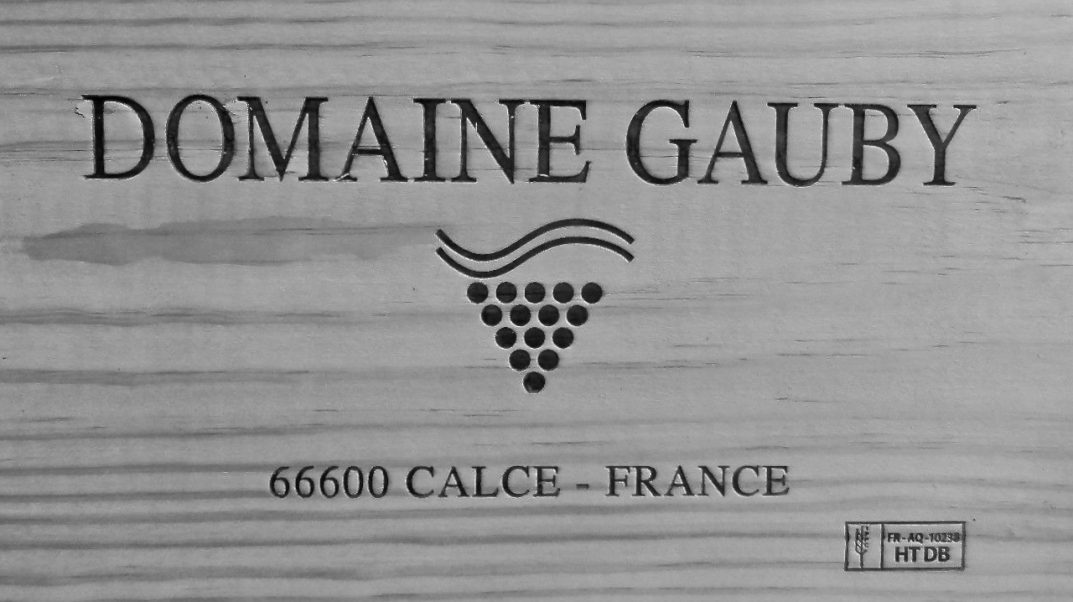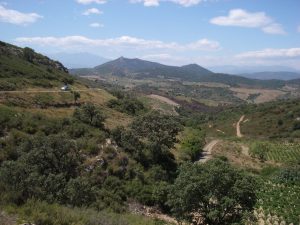Legendary wines from Gérard Gauby
Domaine Gauby, Calce, Agly valley, Roussillon, France
Domaine Gauby is on the slopes of the rugged Agly valley in southern France. It’s inland from Perpignan, near a hamlet called Calce. This valley does not possess a specific wine appellation. Instead, it relies on the vast Côtes du Roussillon for red wines or the Côtes Catalanes for whites. The prettily named Coteaux de Fenouillèdes was dropped in 2003, for the sake of simplicity.
A place of old heresies
Historically, the Agly valley produced either vin ordinaire or sweet wines such as Maury and Rivesaltes. Now there are excellent quality dry whites and reds. Indeed, the best producers here are spectacular.
This place is steeped in violent history, as the vertiginous Cathar fortresses of Quéribus and Peyrepertuse bear witness. These castles and others are the visible remains of the Albigensian heresy, where centuries ago the local Cathar religion was suppressed by massacre and inquisition.
And a place of new ones
In modern times, the Agly valley heresy is Biodynamics. The valley stretches eastwards along the river Agly, from inland Fenouillet and St-Martin, down through Maury and thence to Calce. From there it is but a short journey to Perpignan and the Mediterranean. To the north, the villages of Tautavel and Vingrau signpost the way to the high Corbières. To the south lie the snow-capped Pyrenees and the Spanish border.
The local limestone outcrops here in spectacular fashion, occasionally jumbled up with black schist. At an altitude of around 400 metres, the drive up from Perpignan is a spectacular treat. The views get increasingly panoramic as the road twists between olive groves and almond trees. Tiny vineyards contain gnarled ancient bush vines. Precious little else will grow amidst the stone outcrops and scratchy thin soils of the garrigue.
La Muntada
From Calce, Gauby’s isolated modern home at La Muntada is at the end of a long narrow track. Ghislaine Gauby welcomes us, as does a rather large and over-amorous dog. Afterwards, we descend into the extensive cellars to meet Gérard. There are unlined concrete tanks, old oak foudres and newer oak barriques. The coolness of the cellars makes for a welcome respite from the already rising heat.
Gérard Gauby is big of charisma, charm and build, cutting an imposing figure in the dim cellar light. He greets us with a robust Catalan accent, where vin is pronounced veng. He’s now a winemaking legend. Often referred to as “the uncrowned king of the Roussillon”, such an epithet is richly deserved. No wonder then that a whole wine culture has grown around Gauby. Pilgrims come to pay their respects; wine lovers, acolytes and would-be disciples all want to understand and replicate Gauby’s Midas-touch. The Agly valley is now a quality wine hotspot.
A family-run domaine, Gérard took on just 5 hectares from his Grandfather, Philippe Sol, in 1985. The first change he made was to stop selling grapes to the local co-op. The next was to embrace organics. Gérard says he realised its wisdom after finding dead birds killed by his pesticides. Then, inspired by his friend Marcel Deiss in Alsace, he went Biodynamic in 2001 and also changed his winemaking philosophy; to make wines of balanced alcohol that stress longevity, elegance and finesse.
Domaine Gauby vineyards
The vineyard terroir is the key to the greatness of the wines. It’s dry and sunny here, with sweltering summer temperatures. Altitude is a crucial factor, with most vines at 450-550m. Diurnal variation (hot days and cold nights) encourages longer and slower grape ripening. The result is complexity and freshness in the wines despite the heat.
Gauby’s also consolidated many old vineyard parcels, rescuing them from neglect. There are some 45 hectares under vine, with a diversity of grapes, soils, aspects and slopes.
There are some 150 individual parcels; most are small plots enclosed by ancient dry-stone walls. Between these, there is fallow land, dotted with oak trees and full of wild fennel, rosemary and thyme. There is also some mixed agriculture; cereals, olives and almonds. Such areas act as buffer zones for the vines, preserving habitats and biodiversity, encouraging beneficial insects and birds.
The vineyards are a riot of grasses and weeds. In this arid place, they retain essential moisture and act as a green manure when ploughed in. They also force the vines to deepen their roots in search of water and minerals.
Hard work
“We have the soils, the grapes and the climate to make subtle and authentic wines. But we must work very hard with the vines”, says Gauby. He’s a firm believer that the vineyard makes the wine.
Only Horses plough these vineyards. Meanwhile, the vines are pruned hard into standalone bushes with an open centre, to reduce the risk of fungal diseases. Gauby no longer makes a green harvest in summer because the old vines have such tiny yields. He doesn’t need the extra concentration either. Early picking is also practised to retain acidity and freshness and to moderate grape sugars.
The usual Biodynamic preparations are employed. There is a cow for compost and nettle teas reduce the need for copper-based fungal treatments. Insect control is by spraying tisanes of rosemary and thyme. As proof of BD’s effectiveness, Gauby says the vines don’t shut down with heat stress even during abnormal heat waves.
The grape varieties
In the white grape varieties, there are Carignan Blanc, Chardonnay, Grenache Blanc, Grenache Gris, Macabeo, Muscat, Vermentino and Viognier. In red, there is Carignan, Grenache Noir, Mourvèdre, Syrah and Cabernet Sauvignon.
Most of these varieties are traditional, and many vines are geriatric. Gauby loves old vines that give tiny yields with incredible flavour. The Carignan here is now nearly 150 years old, pre-phylloxera plantings that somehow survived the insects’ ravages.
Viognier, Vermentino, Cabernet Sauvignon and Syrah are relative newcomers. Syrah has been wildly successful, a biotype created by massal selection called Petite Sérine.
As for the Cabernet Sauvignon? Gauby shrugs theatrically. Suffice to say that I think he no longer considers Cabernet as a part of his wine range.
Domaine Gauby winemaking
The winemaking seems deceptively simple, and Gauby plays his skills down. The reality is that he employs natural winemaking techniques to get the results he wants. What he wants is “authenticity”. Gérards son, Lionel, has increasingly taken over the winemaking and as a result, new Cuvées have been added to the range.
The grapes are hand harvested, and a table de tri is used to remove any unhealthy berries. Any beneficial insects found on the sorting table are returned to the land to continue their work. The red grapes receive 2-3 days maceration before fermentation. The whites undergo a slow and gentle pneumatic pressing.
Fermentation takes place in either unlined concrete tanks or older oak foudres, with individual plots kept apart until blending. Fermentation uses wild yeasts, and there is no chaptalisation (addition of sugar) or acidification and minimal sulphur. Neither is there any filtration or fining, just a natural debourbage at low temperature to clarify the wines.
Maturation features a restrained use of oak. Blending is entirely reliant on taste, with the goal being balance, precision and elegance.
“Tasting is everything, that’s how I work out what to do”.
The wines
Gauby’s most revered wines are the red Muntada and the white Coume Ginestre. However, there is much more besides; now there are new single-varietal wines, though I have only tasted those as barrel samples. Below are my selection of the classics; three whites and three reds from the range, at different price points. They equate to the “village”, Premier Cru and Grand Cru hierarchy found in Burgundy. My advice is that if you see any of Gauby’s wines, then just buy them.
White
Les Calcinaires Blanc, IGP Côtes Catalanes. 13%
Typically Muscat, 50%, Macabeo 20%, Chardonnay 30%. Vermentino has also been included more recently. Yields are 20-25 hl/ha.
Tank fermented then eight months on the lees. Calcareous soils. Incredibly floral nose and stunning minerality, richness and elegance. Bone dry and well balanced. Early drinking or keep for a long life ahead, you choose. The Wine Society, £12.50
Vieilles Vignes Blanc, IGP Côtes Catalanes, 12.5%
Typically Macabeo 40%, Grenache Blanc 30%, Carignan Blanc 5%, Grenache Gris 10%, Chardonnay 15%. Yields are only 15 hl/ha. Eight months on the lees, 65% in older oak foudres, 35% in the tank. Calcareous and schist-based soils. 8,000 bottles pa. Vivacity! A creamy yet zingy unoaked wine. Needs ten minutes in the glass to open up. Honey and apricot, creamy texture, minerals. Will benefit from a year or two ageing in bottle. The Solent Cellar, £32.00
Coume Gineste Blanc, IGP Côtes Catalanes, 13%
50% Grenache Blanc and 50% Grenache Gris. New Barriques 50%, older oak foudres with battonage 50%. 12 months maturation. Yield 15 hl/ha. 2,000 bottles pa. Primarily schist plus some calcareous soils. This single vineyard faces north, so retains acidity with more gradual ripening. Coume Gineste is a combe full of yellow broom flowers, the same colour as the wine. The wine has scents of broom and fennel, and without exaggeration, it has the finesse and elegance of a Montrachet. A flinty/chalky minerality lies in wait, and there are butterscotch and hazelnuts on a long fade. My personal favourite of all his wines. Gauby sees my tasting reaction. “Now who cares about appellations?” he says, with a wink. Berry Brothers and Rudd, £66.81
Red
Les Calcinaires Rouge, Côtes du Roussillon Villages, 13%
Typically Grenache Noir 15%, Carignan 10%, Mourvèdre 25%, Syrah 50%. Yields are 25 hl/ha. Older oak foudres 20%, tank 80%, ten months maturation. Calcareous and Schist soils. Brooding colour, blackish core with a purple rim. Very pure red berry fruit flavours with no oak effects, fresh acidity and a long length. Needs a couple of years to mature after release. The Wine Society, £14.95
Vieilles Vignes Rouge, Côtes du Roussillon Villages, 13.5%
Calcareous and schist soils. Typically Grenache Noir 35%, Carignan 40%, Mourvèdre 15%, Syrah 20%. Yields are 20 hl/ha. 24 months maturation in all new oak barriques. 18,000 bottles pa. Deep garnet hue, blackberry fruit and earth. Resinous, sappy finish. Still tannic and dense. Leave five years from release Uncorked, £29.95
Muntada, Côtes du Roussillon Villages, 13.5%
Calcareous soils. Typically Grenache Noir 30%, Carignan 40%, Mourvèdre 15%, Syrah 20%, though the ratio varies with the vintage year. Yields are 15 hl/ha. 20 months maturation; 70% in new oak barrique, 30% in older oak foudres. 8,000 bottles pa. Muntada in the Catalan dialect means Mountain. A cloud of cherry, dried fruit, liquorice and garrigue scents. The palate has a velveteen texture, cherry, red berry and plum. Woodsmoke and hints of leather and balsam on a long finish. Lovely now but this wine has enormous ageing potential. Lay & Wheeler, £44.00
Coda
These wines may have humble appellations, but in Burgundian terms, they really are the Premier Cru and Grand Cru of Southern France. And here’s a final heresy. This domaine equals the best of those in the more famous French regions of Burgundy, Bordeaux, and the Rhône. Doubt that? Just try the wines and decide for yourself.
Location
Ghislaine et Gérard Gauby
Domaine Gauby
La Muntada
66600 Calce
France





